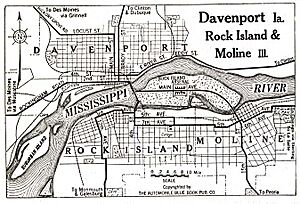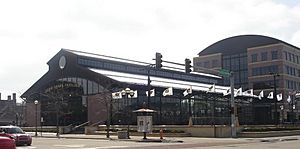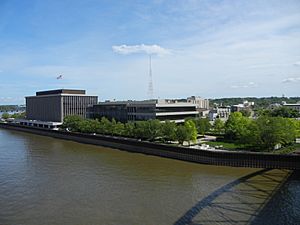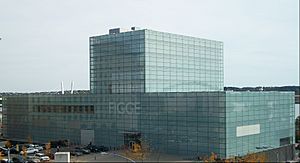Quad Cities facts for kids
Quick facts for kids
Quad Cities, Iowa–Illinois
Davenport–Moline–Rock Island, IA–IL
|
|
|---|---|
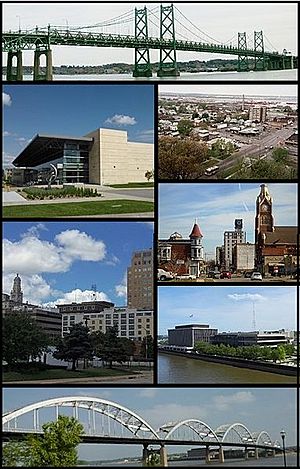 |
|
| Country | |
| State | |
| Largest city | Davenport, Iowa |
| Other cities | Moline, Illinois Bettendorf, Iowa Rock Island, Illinois East Moline, Illinois |
| Area | |
| • Total | 170 sq mi (400 km2) |
| Highest elevation | 850 ft (259 m) |
| Lowest elevation | 590 ft (180 m) |
| Population | |
| • Total | 379,441 (148th) |
| • Rank | 148th in the U.S. |
| • Density | 1,600/sq mi (618/km2) |
| GDP | |
| • Total | $25.774 billion (2022) |
| Time zone | UTC-06:00 (CST) |
| • Summer (DST) | UTC-05:00 (CDT) |
The Quad Cities is a group of cities in the U.S. states of Iowa and Illinois. It was originally four cities, but now includes five main ones. These are Davenport and Bettendorf in Iowa, and Rock Island, Moline, and East Moline in Illinois. They are all located in the beautiful Mississippi River Valley. As of 2023, about 467,817 people live in the main Quad Cities area. The larger surrounding area has about 474,019 people. This makes it the 90th-largest combined area in the United States.
Contents
- Discovering the Quad Cities' Past
- Geography and Location
- People and Cultures
- The Quad Cities Metropolitan Area
- Famous Places and Landmarks
- Important Companies in the Area
- Major Employers
- Famous People from the Quad Cities
- Education Opportunities
- Arts and Culture
- Media in the Quad Cities
- Getting Around: Transportation
- Sports in the Quad Cities
Discovering the Quad Cities' Past
Early Days and Native American History
Long before European settlers arrived, many different indigenous peoples lived in the Quad Cities area. They used the rivers and riverbanks for their homes and trading for thousands of years. When Europeans first came, the Sauk and Fox tribes of Native Americans lived here. Saukenuk was the main village of the Sauk tribe. It was also the birthplace of their famous 19th-century war chief, Black Hawk.
In 1832, after the US won the Black Hawk War, Sauk chief Keokuk and General Winfield Scott signed a treaty in Davenport. This treaty meant the Native Americans gave up a huge amount of land to the United States. In return, they received a much smaller area elsewhere. Today, the Black Hawk State Historic Site in Rock Island protects part of historic Saukenuk. It is a special place listed on the National Register of Historic Places.
River Travel and Industry Growth
The first towns in the Quad Cities grew because of riverboat traffic. For about 14 miles (23 km) between LeClaire, Iowa, and Rock Island, the Mississippi River had rocky parts called "Rock Island Rapids." These rapids made it hard for steamboats to pass. As more boats used the river, navigating these rapids became a big problem.
Over time, a small industry grew here to help the steamboats. Boat crews needed places to rest before the rapids. They also hired expert pilots to guide their boats safely. If the water was low, goods had to be taken off boats and moved by wagons around the rapids. Today, these rocks are hidden under six feet of water. This is because of a lake formed by two locks and dams.
As the Industrial Revolution grew in the United States, many smart business people saw the Mississippi River as a great source of power. The combination of energy and easy river transport attracted new businesses. In 1848, John Deere moved his plow business to Moline. His company, Deere & Company, became official in 1868. Today, John Deere is the biggest employer in the Quad Cities.
The very first railroad bridge across the Mississippi River was built here in 1856. It connected Davenport and Rock Island. The Rock Island Railroad Company built it. This bridge replaced slow ferry services and winter ice bridges. Steamboat owners saw railroads as a threat to their business. On May 6, 1856, soon after the bridge was finished, a steamboat crashed into it. The steamboat owner sued the railroad company. Abraham Lincoln was the lawyer for the railroad company. He won the case, even taking it to the US Supreme Court. This was a very important trial in Lincoln's career.
How the "Quad Cities" Got Its Name
After the Civil War, the towns in this area started to feel like one community. The towns that were well-planned and well-led grew strong. By World War I, Davenport, Rock Island, and Moline called themselves the "Tri-Cities." This was because they were three similar-sized towns growing around a bend in the Mississippi River.
In the 1930s, as Rock Island County grew, the name "Quad Cities" became popular. This happened when East Moline was seen as equally important. Even though the area was called "Quad Cities," the National Basketball Association had a team in Moline from 1946 to 1951 called the "Tri-Cities Blackhawks."
Then, in 1948, a big Alcoa (now Arconic) plant opened near Davenport. This caused Bettendorf to grow a lot. Some people even talked about calling the area the "Quint Cities" (meaning five cities). But the name "Quad Cities" was already well-known. So, "Quint Cities" never really caught on. Even when Bettendorf became larger than East Moline, the name "Quad Cities" stayed. Local leaders decided to include all five cities under the "Quad Cities" name.
Modern Times: Growth and Renewal
Starting in the late 1970s, the economy changed a lot. This caused big industries in the Quad Cities to slow down or close. Major companies like International Harvester (now Navistar) in Rock Island and Case IH in Bettendorf closed their factories. John Deere in Moline cut its number of workers by half. Later in the 1980s, Caterpillar Inc. also closed its factories here.
Since the 1990s, the Quad Cities has worked hard to rebuild the region. Local governments, businesses, and people have achieved great things.
Here are some examples of how the area has been renewed:
- Davenport's River Renaissance project helped bring new life to downtown. It includes a music history center and an art museum. The Figge Art Museum opened in the early 2000s.
- Moline has also invested in its downtown. The "John Deere Commons" and the Vibrant Arena at The MARK (a large arena) both opened in the 1990s.
- In 2007, Davenport and Rock Island won the title of "most livable small city." This was from the National Council of Mayors.
- In 2008, CNN ranked Bettendorf as one of the top ten best places to buy a house in the United States.
- Forbes magazine called the Quad Cities "the most affordable metro" in 2010.
- In 2012, Davenport's housing market was ranked second in the nation for its strength. This was due to low home foreclosures and low unemployment.
- Also in 2012, the Quad Cities Metropolitan Area was among the fastest-growing areas for high-tech jobs.
- The Quad Cities was named an "All American City" in 2012.
- In 2013, Modern Woodmen Park was voted the best minor league ballpark in America.
Mergers and Community Growth
Over the years, some communities in the Quad Cities have thought about joining together. Davenport has grown by adding smaller towns like Rockingham and East Davenport. Bettendorf also added parts of Pleasant Valley in the 1970s.
In 1987, several Illinois cities, including Rock Island, Moline, and East Moline, considered forming one very large city. This would have made it the second-largest city in Illinois. However, the idea did not pass. Moline and East Moline thought about merging in 1997. That same year, Green Rock and Colona did merge. Bettendorf and Riverdale also considered joining together.
Geography and Location
The Quad Cities is located where the Rock River meets the Mississippi River. It is about 140 miles (225 km) west of Chicago. This area is the largest metropolitan area along the Mississippi River between Minneapolis–Saint Paul and St. Louis. Interstate 80 crosses the Mississippi River here.
The main Quad Cities metropolitan area includes three counties: Scott County in Iowa, and Rock Island County and Henry County in Illinois. The Quad Cities area is also part of the larger Great Lakes Megalopolis.
A unique thing about the Quad Cities is that the Mississippi River flows from east to west here. This means the Iowa cities of Davenport and Bettendorf are directly north of Rock Island and Moline.
| Climate data for Quad Cities (Quad City International Airport), 1981–2010 normals, extremes 1871–present | |||||||||||||
|---|---|---|---|---|---|---|---|---|---|---|---|---|---|
| Month | Jan | Feb | Mar | Apr | May | Jun | Jul | Aug | Sep | Oct | Nov | Dec | Year |
| Record high °F (°C) | 69 (21) |
74 (23) |
88 (31) |
93 (34) |
104 (40) |
104 (40) |
111 (44) |
106 (41) |
100 (38) |
95 (35) |
80 (27) |
71 (22) |
111 (44) |
| Mean daily maximum °F (°C) | 31.0 (−0.6) |
35.7 (2.1) |
48.8 (9.3) |
62.3 (16.8) |
72.9 (22.7) |
82.3 (27.9) |
85.8 (29.9) |
83.8 (28.8) |
76.8 (24.9) |
64.1 (17.8) |
49.2 (9.6) |
34.6 (1.4) |
60.6 (15.9) |
| Mean daily minimum °F (°C) | 14.3 (−9.8) |
18.3 (−7.6) |
29.4 (−1.4) |
40.5 (4.7) |
50.7 (10.4) |
60.7 (15.9) |
65.0 (18.3) |
63.2 (17.3) |
53.9 (12.2) |
42.4 (5.8) |
30.9 (−0.6) |
18.6 (−7.4) |
40.7 (4.8) |
| Record low °F (°C) | −27 (−33) |
−28 (−33) |
−19 (−28) |
7 (−14) |
25 (−4) |
39 (4) |
46 (8) |
40 (4) |
24 (−4) |
11 (−12) |
−10 (−23) |
−24 (−31) |
−28 (−33) |
| Average precipitation inches (mm) | 1.49 (38) |
1.60 (41) |
2.86 (73) |
3.59 (91) |
4.32 (110) |
4.49 (114) |
4.29 (109) |
4.52 (115) |
3.09 (78) |
2.97 (75) |
2.56 (65) |
2.18 (55) |
37.96 (964) |
| Average snowfall inches (cm) | 9.4 (24) |
6.8 (17) |
4.0 (10) |
0.9 (2.3) |
0 (0) |
0 (0) |
0 (0) |
0 (0) |
0 (0) |
0 (0) |
1.2 (3.0) |
9.3 (24) |
31.6 (80) |
| Average precipitation days (≥ 0.01 in) | 8.8 | 8.3 | 10.1 | 11.0 | 11.7 | 10.5 | 9.8 | 9.8 | 8.2 | 9.1 | 9.8 | 10.0 | 117.1 |
| Average snowy days (≥ 0.1 in) | 7.1 | 5.6 | 3.2 | 0.7 | 0 | 0 | 0 | 0 | 0 | 0 | 1.7 | 6.8 | 25.1 |
| Average relative humidity (%) | 69.9 | 69.8 | 68.3 | 64.3 | 64.9 | 65.8 | 70.5 | 73.3 | 72.8 | 68.1 | 71.3 | 74.0 | 69.4 |
| Mean monthly sunshine hours | 148.1 | 153.8 | 180.5 | 210.1 | 255.1 | 284.6 | 301.9 | 271.4 | 222.0 | 192.9 | 121.7 | 113.9 | 2,456 |
| Percent possible sunshine | 50 | 52 | 49 | 53 | 57 | 63 | 66 | 63 | 59 | 56 | 41 | 40 | 55 |
| Source: NOAA (relative humidity and sun 1961−1990) | |||||||||||||
People and Cultures
Population and Backgrounds
In 2010, the metropolitan area had 471,551 people. In 2000, there were 96,495 households and 60,535 families living in the area.
Most people in the Quad Cities are White (90.6%). There are also significant populations of Black or African American (3.7%), Asian (1.0%), and people from two or more races (2.0%). About 7.1% of the population is Hispanic or Latino. Many people in the Quad Cities have family roots from northern Europe. This includes German, Irish, English, Swedish, Norwegian, and Dutch backgrounds.
The main minority group in the area is African-Americans. Davenport has the third-largest Black population in Iowa. This community dates back to the 1830s when Iowa was a free territory. Many African-American residents have family ties to states like Mississippi, Arkansas, Alabama, and Missouri. The largest Asian-American groups are from South Asia and Vietnam.
Religions in the Area
Christianity is the largest religion practiced in the Quad Cities. However, the types of Christian groups vary between Iowa and Illinois. In Davenport and Bettendorf, Catholics make up the largest group (18.5%). Protestants are also a big part of the community, including Mainline (15.1%) and Evangelical (11.6%) groups. Black Protestants make up 1.2% on the Iowa side.
On the Illinois side, in Rock Island, Moline, and East Moline, Catholicism is less common (12.4%). Evangelical (12.5%) and Mainline (11.0%) Protestant groups are also present. The Jewish population in the area is about 500–600 people. This is a decrease from about 1,800–2,000 people in the 1950s and 1960s.
The Quad Cities Metropolitan Area
The Quad Cities metropolitan area is officially called the Davenport–Moline–Rock Island Metropolitan Statistical Area (MSA). It includes four counties: Scott County in Iowa, and Henry, Mercer, and Rock Island counties in Illinois. In 2020, this area had an estimated population of 384,324.
This metropolitan area is also considered part of the Great Lakes Megalopolis. It is the largest metropolitan area along the Mississippi River in Iowa. It is also the largest between Minneapolis–Saint Paul and the St. Louis area.
Famous Places and Landmarks
The Quad Cities has many interesting places to visit:
- The business Antique Archeology, from the TV show American Pickers, is in LeClaire.
- The Figge Art Museum in Davenport has amazing art collections. It opened in 2005.
- The Fred Schwengel Memorial Bridge carries Interstate 80 over the Mississippi River. It connects LeClaire, Iowa, with Rapids City, Illinois.
- The Government Bridge is a two-level bridge next to Lock and Dam 15. It carries cars and trains between Arsenal Island and Davenport.
- The Iowa 80 Truck Stop is the world's largest truck stop. It is located near Walcott, Iowa, west of Davenport.
- The Interstate 74 Bridge connects Bettendorf and Moline. Its twin towers are a symbol of the two-state Quad Cities community. A new, wider bridge is being built to replace it.
- The John Deere Pavilion in Moline is a museum and showcase for John Deere equipment.
- The John Deere World Headquarters in Moline was designed by famous architect Eero Saarinen.
- Lock and Dam No. 15 is a large dam with twin locks across the Mississippi River. It helps river traffic pass through the area.
- Modern Woodmen Park in Davenport is home to the Quad Cities River Bandits baseball team. It was named one of the best places for a baseball trip by USA Today. It even has a ferris wheel!
- Old Main is the oldest building at Augustana College in Rock Island. Its dome is a well-known sight.
- The Putnam Museum in Davenport is a great place to learn about history and science.
- The Quad City Botanical Center in Rock Island is a beautiful garden.
- The Rock Island Arsenal is a large government factory for military equipment. It is on Arsenal Island in the Mississippi River.
- The Rock Island Centennial Bridge connects downtown Davenport and Rock Island. Its five arches are often used as a symbol for the Quad Cities.
- The Vibrant Arena at The MARK is a 12,000-seat arena in Moline. It hosts many concerts and sports events.
- Vander Veer Botanical Park in Davenport is one of the first botanical parks west of the Mississippi River.
- The TBK Bank Sports Complex, also known as the BettPlex, is a huge sports and entertainment center in Bettendorf. It hosts many weekend sports tournaments.
Important Companies in the Area
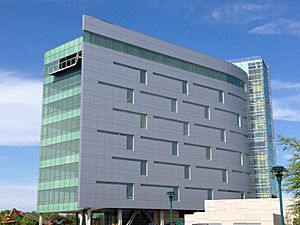
The Quad Cities is home to many important companies. Some of these include:
- Arconic
- Cobham plc
- Deere & Company (John Deere)
- Genesis Health System
- Group O
- Guardian Industries
- Happy Joe's
- KONE, Inc
- Lee Enterprises
- Lewis Machine and Tool Company
- Modern Woodmen of America
- Nestlé Purina PetCare
- QCR Holdings
- Sears Seating
- Von Maur
- Whitey's Ice Cream
Major Employers
Here are the top employers in the Quad Cities area:
| Rank | Employer | # of employees | Industry |
|---|---|---|---|
| 1 | Deere & Company | 6,700 | Agricultural Innovation |
| 2 | Rock Island Arsenal | 6,300 | Defense Manufacturing |
| 3 | UnityPoint Health - Trinity | 6,100 | Healthcare |
| 4 | Genesis Health System | 4,700 | Healthcare |
| 5 | Hy-Vee | 4,200 | Grocery |
| 6 | Walmart | 3,600 | Warehouse Clubs and Supercenters |
| 7 | HNI Corporation/The Hon Company/Allsteel | 3,100 | Office Furniture Manufacturing |
| 8 | Arconic | 2,400 | Aerospace and Defense Aluminum |
| * | Tyson Fresh Meats | 2,400 | Food Processing |
| 10 | Amazon | 1,500 | Conglomerate |
Famous People from the Quad Cities
Many notable people have come from the Quad Cities area. Here are just a few:
- Eddie Albert, actor
- Ken Anderson, football player and coach
- Bix Beiderbecke, jazz musician
- Louis Bellson, drummer
- Ken Berry, actor
- Chief Black Hawk, Sauk leader
- Isabel Bloom, artist
- William F. "Buffalo Bill" Cody, pioneer
- John Deere, inventor
- Abraham Lincoln, lawyer (worked on a famous case here)
- Don Nelson, NBA basketball player and coach
- Seth Rollins, WWE wrestler
- Jim Skinner, CEO of McDonald's
- Tim Sylvia, MMA fighter
Education Opportunities
Colleges and Universities
The Quad Cities offers many choices for higher education:
- Augustana College – A private, four-year college in Rock Island.
- Black Hawk College – A community college in Moline.
- Eastern Iowa Community College District – Has campuses in Bettendorf, Clinton, Davenport, and Muscatine.
- Palmer Chiropractic College – Located in Davenport, it was the first chiropractic school in the world.
- Saint Ambrose University – A private university in Davenport.
- Upper Iowa University – Has a satellite campus in Bettendorf.
- Western Illinois University-Quad Cities – The only public, four-year university in the region. It is in Moline along the Mississippi Riverfront.
Arts and Culture
The Quad Cities has a rich cultural scene. Since 1916, the Quad City Symphony Orchestra has performed concerts all year. The Handel Oratorio Society, started in 1880, is one of the oldest groups of its kind in the nation. They perform "Messiah" every year. The Augustana Choir is also one of the country's top college choirs.
In the summer, you can enjoy outdoor music festivals. These include the Bix Beiderbecke Memorial Jazz Festival and the Mississippi Valley Blues Festival.
The area has several community theaters:
- Playcrafters Barn Theatre (comedies and dramas)
- Quad City Music Guild (musicals)
- Genesius guild (outdoor Shakespeare)
- Circa '21 Dinner Playhouse (a professional dinner theater)
You can also see ballet at Ballet Quad Cities. ComedySportz offers fun improv comedy. Many historic buildings and sites are listed on the National Register of Historic Places. They help us understand the area's past.
Media in the Quad Cities
The Quad Cities is a big area for radio and TV. It has over 13 commercial radio stations and 8 non-commercial stations. There are also 8 TV stations and 3 daily newspapers.
In 2012, the Mississippi Valley Fair in Davenport was used to film Rodney Atkins' music video "Just Wanna Rock N' Roll."
Getting Around: Transportation
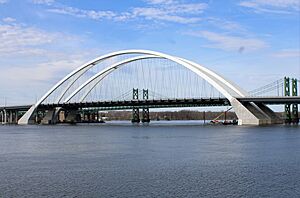
Four interstate highways serve the Quad Cities: Interstate 80, Interstate 280, and Interstate 74 go through both states. Interstate 88 is only in Illinois. Other major highways include U.S. Route 6 and U.S. Route 67.
Five bridges connect Iowa and Illinois across the Mississippi River for cars:
- The Fred Schwengel Memorial Bridge (I-80) connects Le Claire, Iowa, with Rapids City, Illinois.
- The I-74 Bridge connects Bettendorf, Iowa, with Moline, Illinois. It is the busiest bridge.
- The Government Bridge connects Downtown Davenport with the Rock Island Arsenal.
- The Rock Island Centennial Bridge connects Davenport and Rock Island.
- The Sergeant John F. Baker, Jr. Bridge (I-280) also connects Davenport and Rock Island.
There are three public transportation systems in the Quad Cities. Quad Cities MetroLINK serves the Illinois cities with buses and a summer river craft. In Iowa, Davenport Citibus and Bettendorf Transit operate bus routes.
Amtrak train service does not currently stop in the Quad Cities. The closest station is in Galesburg, Illinois, about 50 miles (80 km) away. However, there are plans to bring Amtrak service to Moline, connecting it to Chicago. The new Moline Q Station building was finished in 2018. When the project is complete, passenger rail will return to the Quad Cities for the first time since the 1970s.
The Quad Cities International Airport in Moline is Illinois' third-busiest airport. It offers flights as an alternative to larger airports in Chicago. The smaller Davenport Municipal Airport hosts the Quad City Air Show.
Sports in the Quad Cities
The Quad Cities has a long history with sports. From 1907 to 1926, Rock Island was home to the NFL's Rock Island Independents. They played the first NFL game ever in September 1920. Football legend Jim Thorpe played for the team in 1924.
The Tri-Cities Blackhawks were a top professional basketball team. They played in the National Basketball League from 1946. In 1949, they joined the new National Basketball Association (NBA). Famous coach Red Auerbach coached the Blackhawks. After the 1950–51 season, the team moved and eventually became the Atlanta Hawks.
Professional basketball returned with the Quad City Thunder in the 1980s and 1990s. They played in the Continental Basketball Association. The Vibrant Arena at The MARK sometimes hosts college basketball tournaments and NBA/NHL exhibition games.
Minor league baseball has been in the Quad Cities since 1878. Today, the Quad Cities River Bandits are a High Class A team for the Kansas City Royals. They play at Modern Woodmen Park in Davenport.
The PGA Tour golf tournament, the John Deere Classic, happens here every year. Many top golfers have played in it.
The Quad Cities Marathon runs every September. Runners race through the four cities, starting and ending in Moline.
Local Sports Teams
| Club | Sport | League | Venue | Established | Championships |
|---|---|---|---|---|---|
| Quad Cities River Bandits | Baseball | Midwest League | Modern Woodmen Park | 1960 | 6 |
| Quad City Steamwheelers | Indoor football | IFL | Vibrant Arena at The MARK | 2017 | 0 |
| Quad City Storm | Ice hockey | SPHL | Vibrant Arena at The MARK | 2018 | 0 |
- The Quad City River Bandits are a Class A minor league baseball team in Davenport. They are linked with the Kansas City Royals.
- The Quad City Storm is an ice hockey team that started in 2018. They play in the Southern Professional Hockey League.
- The Quad City Steamwheelers are an arena football team. They won league titles in 2000 and 2001. A new Steamwheelers team started in 2018.
- Pat Miletich started a famous mixed martial arts gym, Miletich Fighting Systems, in the Quad Cities. Many top fighters trained there.
- The Quad City Raiders are a semi-professional football team. They were formed in 2011.


